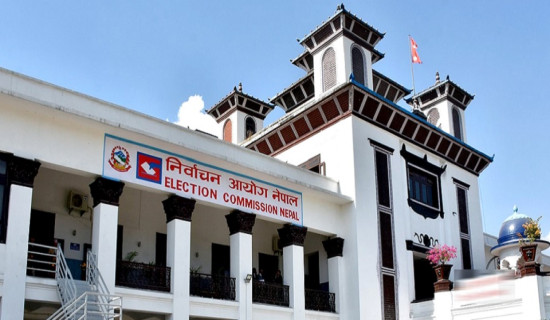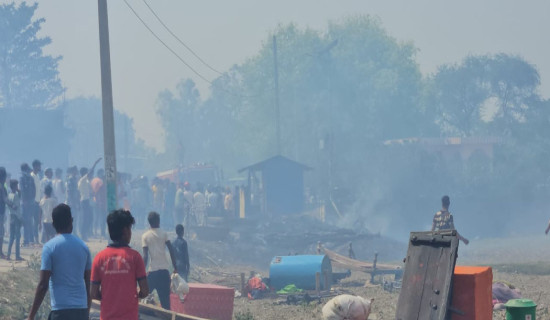- Thursday, 25 April 2024
The Asian Paradise Flycatcher
Rajesh Dhungana
The famous Bouddheshwar Mahadev Temple lies near the buffer zone of Shivapuri National Park in Kathmandu. Located at the foot of Shivapuri hill and the lower part of Jhor Waterfall in Ward No. 1 Tokha Municipality, the area where the temple stands is knowns as Patikhet.
These days one can see a crowd near the temple, not to offer worship but to see the Asian paradise flycatcher (Terpsiphone paradisi) and take pictures of the rare birds. Now the Asian paradise flycatchers have made four nests in this area.
According to Radha Adhikari, a 34-year-old local hotelier, the Asian paradise flycatchers have been roaming in the area for the past few years. They make nests and hatch chicks. Compared to previous years, this year there is a bigger crowd of bird watchers. A lot of people come here at 7 in the morning and take pictures throughout the day. Two photographers from Pokhara and Butwal also came here to take pictures of these birds.
“With the crowds of bird watchers, my hotel business has also flourished,” said Adhikari.
Earlier, the locals called the bird "Lampuchhre". Later they were surprised to hear its real name and started to learn about this bird, added Adhikari. Now locals have named the place "Swargachari" after the birds. It is said that different species of birds are seen in this area.
Adhikari said she was sad that nobody was taking care for such important birds. Sometimes the Asian paradise flycatchers make a nest in a tree in the farmland. But the farmers sometimes cut the trees and destroy their nests.
With the ever-swelling crowd to observe the bird, traffic has also increased in the area.
Full of natural beauty, this place has a waterfall. As it is located at the foot of the hill, the environment is very calm, and due to the greenery all around, different species of birds can be seen in this place.
“This bird has been seen in this area for several years,” said Kiran Raj Thapa, wildlife photographer and nature lover. Thapa has been tracking and photographing this bird for the past three years. He had previously visited this spot many times to click photos and had captured some extremely amazing images. This bird is rare and beautiful.
The Asian paradise flycatcher is particularly well known for its magnIoicent tail. This bird is called "Swargachari" in Nepali. This medium-sized bird is native to Asia and is widely distributed. This bird is also native to the Indian subcontinent, Central Asia, and Myanmar. The head of this bird is mainly glossy black in colour.
The main characteristic of this bird is that the males have a long feathered main tail, which can be more than 12 inches long, while the body of the bird is 7 to 8 inches long. Some have black rufous feathers, while others have white feathered tails.
The female has a black head with a short reddish-brown tail. The Asian paradise flycatchers have a wingspan of 3.4 to 3.6 inches. The main food of the Asian paradise flycatcher is insects, butterflies and flies.
Asian paradise flycatchers mostly prefer to live in forests where there are trees with good height. Apart from this, these birds are also found in gardens, shady trees, light deciduous forests and wet forests. The beak of this bird is small and circular in shape. The sound of this bird keeps indicating its presence. Their nests look like a small basket.
The colour of the male bird is similar to that of the female until puberty but the colour changes as it matures. This is a playful bird. Its goons are very covert and seldom touch the ground. This bird flies back and forth, rarely perching for an extended period of time on a tree branch. The bird looks even more stunning when flying because of its magnIoicent wings and long tails.

Breeding
The Asian paradise flycatcher mostly breed from May to July. Both male and female engage in construction of nest, incubating the eggs, and feeding and protecting the hatchlings. This bird lays 4 to 5 eggs which are incubated for about 21-23 days.
The cup shaped nest is typically found at the end of a low tree branch and is constructed from twigs that have been tied together by cobwebs. Bands are sometimes formed around breeding pairs, keeping predators at bay.
Features
The Asian paradise-flycatcher is a medium-sized bird with males having long median tail feathers, with black and rufous plumage, or white plumage. Females have rufous wings and short tails with black heads. Male birds acquire long tails in their second or third years. Adult males are either mainly bright rufous above or mainly white. Some specimens are intermediate between rufous and white. Long-tailed rufous birds are generally devoid of shaft streaks on the wings and tail feathers while white birds have shaft streaks and sometimes black on the edges of the wings and tail feathers.
Varieties
Corvus paradisi was the scientific name proposed by Linnaeus in 1758. The Abachamba Paradise Flycatcher is placed in the family Monarchidae, along with the Old-World flycatchers. Until 2015, the Indian Paradise Flycatcher, Blythe Paradise Flycatcher, and Amur Paradise Flycatcher were all considered distinct and together called the Asian Paradise Flycatcher. Linnaeus thought that the Indian Paradise Flycatcher struck only in India. Later, ornithologists observed it in other regions and described several subspecies based on differences in male plumage. T.P. Paradise breeds in central and southern India, central Bangladesh, and south-west Myanmar.

The Himalayan Paradise Flycatcher was originally described as a separate species. It breeds in western Tibet, Afghanistan, and northern Pakistan; northwestern and central India; and western and central Nepal. Populations in eastern Pakistan and southern India migrate to the Himalayan foothills to breed in spring.
This bird was recognised as the state bird of Madhya Pradesh, India, in 1985 and is known locally as "Dudhraj Chara". In the early 1960s, research on the Asian paradise flycatcher was conducted in which 680 long-tailed males were studied. As the global population of the Asian Flycatcher Paradise is considered stable, it was listed as Least Concern on the International Red List since 2004.
The bird is mainly a summer visitor for Nepal. Common in Chitwan National Park, Bardiya National Park and Parsa Wildlife Reserve and frequent in Shuklaphanta Wildlife Reserve. They are rare in the far western Shuklaphanta Wildlife Reserve (Baral and Iskip 2009).
“We do not have a conservation programme focused on this species of bird. This species is included in other species conservation efforts,” said, Mohan Bikram Shrestha, Research Officer of Bird Conservation Nepal.
(The author is a wildlife photographer. All photos used in the article are taken by him.)
How did you feel after reading this news?















